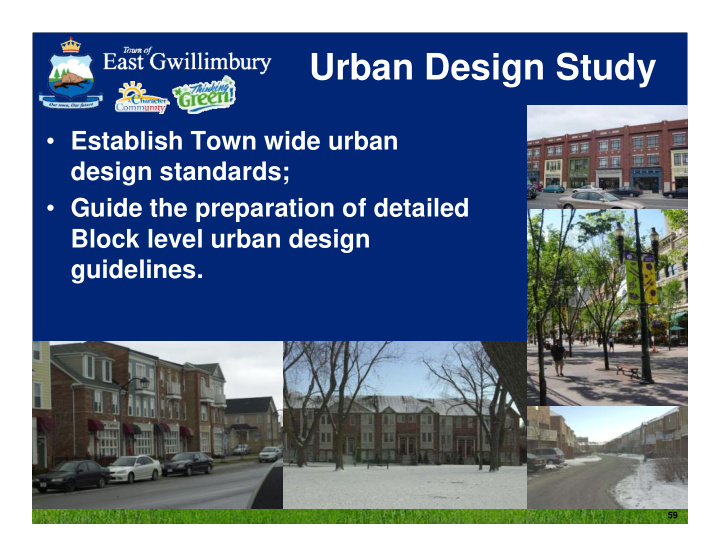



Urban Design Study • Establish Town wide urban design standards; • Guide the preparation of detailed Block level urban design guidelines. 59
Goals of the Design Guidelines • Consolidate existing design policies, update with new guidelines and establish design concepts for specific areas • Recommend policies for future implementation and control to ensure the highest level of community design 60
Sample Objectives of the Guidelines Streetscape Objectives • Connected street systems; • Visually attractive streetscapes; • Enhancement of pedestrian experience and convenience; • Variety of street section standards reflecting local context & character; • Use of high quality of landscaping; • Enhancement of community identity; • Creation of Community meeting places in focal areas. Open Space Objectives • Development of fully linked open space system; • Preservation of Natural heritage features; • Full range of open spaces including natural lands, parks, parkettes, pedestrian links, trail systems; • Enhancement of views to and from open spaces; • Sustainable vegetation and design of open space and stormwater facilities as community open space features. 61
Sample Objectives of the Guidelines Residential Development Objectives • Promotion of diversity through range of housing types and densities; • Integration of higher density and mixed use built form; • Built form responding to local context and built heritage; • Built form that addresses the street & reinforces pedestrian streetscapes; • Built form that promotes sustainability. Mixed Use and Commercial Objectives • Promotion of mixed use built form at focal nodes and commercial areas; • Street related retail - mainstreets; • Enhancement of pedestrian comfort and convenience in commercial areas; • Minimize impact of parking on streetscapes; • Integration of community and institutional uses located within these focal areas. 62
Sample Objectives of the Guidelines Employment Area Objectives • Establish a distinct, attractive, prestigious business image; • Promote high quality streetscapes; • Promote pedestrian connectivity and access to amenities; • Support the transit and cycling; • Minimize the impact of vehicles on the streetscape; • Visually attractive buildings to promote prestige business image; • Encourage innovative architectural design; • Integrate building design with adjacent open space systems. 63
Sample Objectives of the Guidelines Sustainability Objectives • Promote healthy and sustainable vibrant community through efficient use of land, diversity of uses and proximity of amenities; • Promote efficient use of energy and material resources in community and built form and landscape design; • Promote interactions and connectedness within a community and to nearby communities; • Promote livability, transportation efficiency, walkability and alternate modes of transit; • Enable citizens from a wide range of economic levels and age groups to live within the community and ensure basic needs are met within the community. 64
Recommend
More recommend